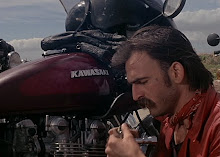If you mention the Gilera name to most people today, they'll either know the company as a maker of mopeds, scooters, and small-bore motorcycles or they'll give you a confused look.
That was not always the case, however. In the years before and after World War II, Gilera was the maker of a series of fearsome four-cylinder racing machines. That's quit a difference from their current position as being another one of Piaggio's many brands.
In the 1950s, Gilera's mighty 500 Four won six championships in eight years, including five straight from 1952 until 1957. They also won Isle of Man TT in 1955 and 1957.
Those big air-cooled fours belted out 70 hp and with the bathtub fairings of the day would propel the bike to 160 mph. After 1957 season, the declining prices of cars in Italy and the escalating costs of racing caused the Italian manufacturers to come to a gentleman's agreement: they would all pull out of racing. The dominating era of the Gilera Four came to an end.
After pulling out of racing, Gilera concentrated on small road machines and was purchased by Piaggio in 1969. They have gone on to produce motorcycles of various sizes, along with mopeds and scooters. The company also made a comeback to racing in 1992 and has won championships in the 125cc class in 2001 and the 250cc class in 2008.
But what kicked off their era of dominance? How did a company that now sells rebadged Piaggio MP3s once rule the racing world? Well, it starts with the purchase of an aircraft engine.
In 1923, two Roman engineers named Carlo Gianini and Piero Remor, with capital invested by wealthy Roman count Giovanni Bonmartini, designed a 500cc four-cylinder engine for aircraft use. The supercharged engine was originally air-cooled but was later redesigned for liquid-cooling. This engine was eventually purchased by the Caproni aircraft company, who then later sold it to Gilera.
The only similarities between this engine and later the Gilera fours was the number of cylinders and the displacement. This engine was angled forward at a steep 45° and was liquid-cooled. Nestled behind the cylinders was a rotating lobe supercharger and the exhaust was a four-into-two setup.
Shoving an airplane engine into a motorcycle frame isn't exactly easy. A special frame was designed and it was similar in concept to Yamaha's Deltabox frame that would arrive nearly 50 years later. Two layers of steel tubes ran along the sides of the powertrain and connected to a large spar just under the seat. This odd frame concept was necessary not only because of the engine's
width but because of the size and placement of the radiator. The front suspension was a traditional girder-style and the scissor-type dampers for the rear suspension were of a pivoting fork design.
This machine debuted in 1937 and immediately began to make an impact. Piero Taruffi guided it to 170 mph over the flying kilometer and into the record books. The next year, the 500 Gilera won at Taranto and Lario. In 1939, Dorino Serafini rode the bike to a record-breaking win at the Ulster Grand Prix in Ireland and on to a world championship. The next year, the fascinating Gilera was gone.
The innovative chassis played a part in the Gilera's success but the lion's share went to the engine. It pumped out 85 hp and with the unitized four-speed gearbox and sans fairing, the machine would hit 143 mph. Put a fairing on it and top speed went up to 170 mph. That was truly heady stuff for the day.
This Gilera is an important piece of motorcycle history. It's innovative chassis and powerful engine put the world on notice and paved the way for Gilera's future domination. The 500s that came later would be less radical, however. Their engines were naturally-aspirated and air-cooled while their frames were more traditional.
It's a shame that the gentleman's agreement between the Italian manufacturers ended Gilera's reign. They were such iconic and ground-breaking machines and it's sad to see the Gilera name on scooters and mopeds and not on world-beating superbikes. I don't think ever got to see just what Gilera was capable of.
I think the world was cheated.
Subscribe to:
Post Comments (Atom)

No comments:
Post a Comment